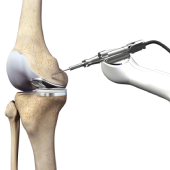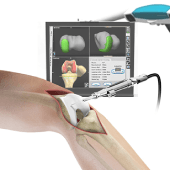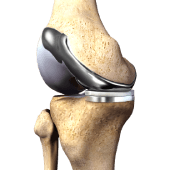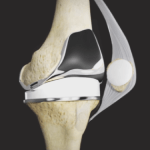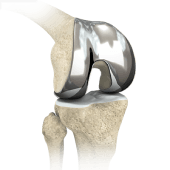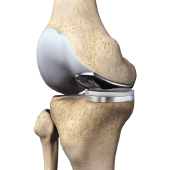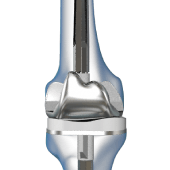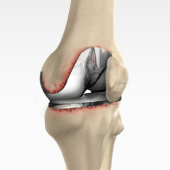Knee Procedures
- Anatomy
- Conditions
- Procedures
Mako Robotic-Arm Assisted Technology for Total Knee Replacement
Mako Robotic-Arm Assisted Total Knee Replacement is a treatment option for adults living with mid to late-stage osteoarthritis (OA) of the knee. Mako provides you with a personalized surgical plan based on your unique anatomy. First, a CT scan of the diseased knee joint is taken. This CT scan is uploaded into the Mako System software, where a 3D model of your knee is created. This 3D model is used to pre-plan and assist your surgeon in performing your total knee replacement.
Total Knee Replacement
Total knee replacement, also called total knee arthroplasty, is a surgical procedure in which the worn out or damaged surfaces of the knee joint is removed and replaced with an artificial prosthesis.
Unicondylar knee Replacement
Unicompartmental knee replacement is a minimally invasive surgery in which only the damaged compartment of the knee is replaced with an implant. It is also called a partial knee replacement. The knee can be divided into three compartments: patellofemoral, the compartment in front of the knee between the knee cap and thigh bone, medial compartment, on the inside portion of the knee, and lateral compartment which is the area on the outside portion of the knee joint.
Computer Navigation for Total Knee Replacement
Computer navigation provides your surgeon with real-time 3-D images of your mapped knee and the surgical instruments during surgery. The data for the images is provided by infrared sensors fixed to the bones of the knee and surgical instruments. Their position is tracked by an infrared camera placed above the surgical table, which is connected to a computer.
Revision Knee Replacement
Revision knee replacement surgery involves replacing a part or all your previous knee prosthesis with a new prosthesis. Although total knee replacement surgery is successful, sometimes the procedure can fail due to various reasons and may require a second revision surgery.
Custom Knee Replacement
Custom Knee Replacement is an advanced surgical procedure in which the damaged knee joint is replaced by a customized implant, specifically designed to match the unique size and shape of each patient’s knee.
Unicompartmental/Partial Knee Replacement
Unicompartmental knee replacement is a minimally invasive surgery in which only the damaged compartment of the knee is replaced with an implant. It is also called a partial knee replacement. The knee can be divided into three compartments: patellofemoral, the compartment in front of the knee between the kneecap and thighbone, the medial compartment, on the inside portion of the knee, and lateral compartment which is the area on the outside portion of the knee joint.
Robotic Unicondylar Knee Replacement
A unicondylar knee replacement is a procedure to replace part of the knee joint with a prosthetic implant to relieve pain and improve the function of the joint. Advances in technology have allowed this procedure to be performed in a minimally invasive manner with robotic assistance.
Tricompartmental Knee Replacement
Tricompartmental knee replacement, also called total knee arthroplasty, is a surgical procedure in which the worn-out or damaged surfaces of the knee joint are removed and replaced with artificial parts.
Custom-fitted Total Knee Arthroplasty
Custom-fitted total knee arthroplasty is a newer more advanced technology in total knee replacement surgery that uses an individualized patient-specific knee implant for the replacement of all three components of the knee.
Partial Medial Knee Replacement
Partial medial knee replacement is a surgery to replace only the medial part of your damaged knee. It is also called unicompartmental knee replacement. The knee is one of the largest and complex joints in your body. The joint is connected to your thigh bones and bones of the lower leg by various ligaments. The knee joint is made of three compartments, the lateral, medial and patellofemoral compartments. The inside part of your knee is the medial compartment of the knee. It consists of a medial collateral ligament (MCL).
Correction of a Failed Knee Replacement
Reoperation of a total knee replacement to resolve a painful knee condition and loss of motion arising out of a damaged or worn out prosthesis is known as correction of a failed knee replacement. This procedure involves a partial or complete exchange of the prostheses that were implanted during the original total knee replacement with new prostheses.
Correction of a Painful Knee Replacement
Reoperation of a total knee replacement to resolve a painful knee condition and loss of motion arising out of a damaged or worn out prosthesis is known as correction of a painful knee replacement. This procedure involves a complete or partial exchange of prostheses implanted during the original total knee replacement with new prostheses.
Outpatient Unicondylar Knee Replacement
A unicondylar knee replacement, also known as unicompartmental or partial knee replacement, is a procedure to replace a portion of the damaged knee joint with a prosthetic implant to relieve pain and improve function of the knee joint. Traditionally performed as an inpatient procedure, advances in technology have allowed this procedure to be performed in a minimally invasive manner on an outpatient basis allowing patients to go home the same day of the surgery
Others
Non-Surgical Knee Treatments
The knee is a complex joint which consists of bone, cartilage, ligaments, and tendons that make joint movements easy and at the same time it is more susceptible to various kinds of injuries. Knee problems may arise if any of these structures get injured by overuse or suddenly during sports activities. Injuries to the knee can be caused by degenerative diseases such as arthritis, traumatic injuries, and sports injuries.
Am I a Candidate for Knee Surgery?
Arthritis of the knee can cause pain and stiffness, making regular activities such as walking and bending difficult. As arthritis progresses, conservative treatments tend to lose their efficacy and more definitive treatment should be considered. Knee replacement surgery involves replacing worn or damaged joints with implants to reduce pain and improve movement. It provides excellent results for many and is usually performed on those above 60 but may also benefit young patients with certain conditions.
- Anatomy
- Conditions
- Procedures

